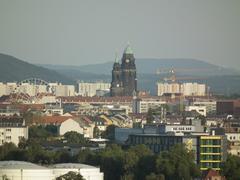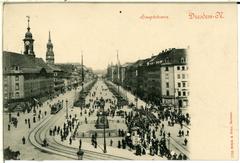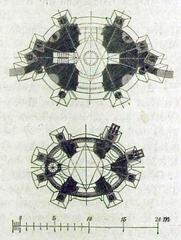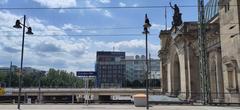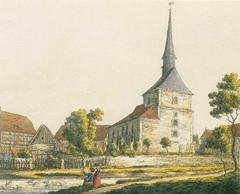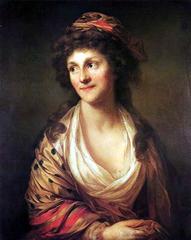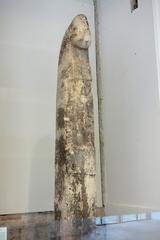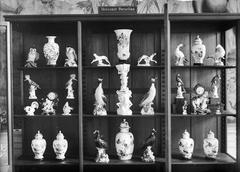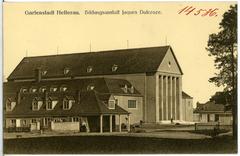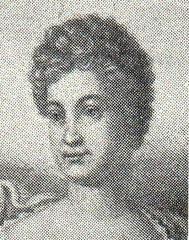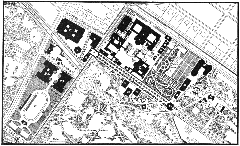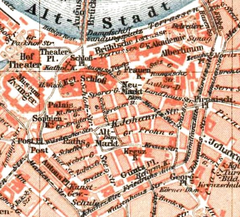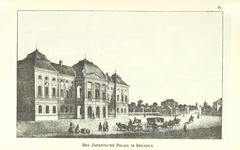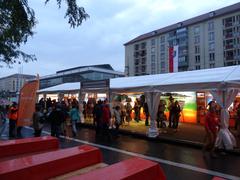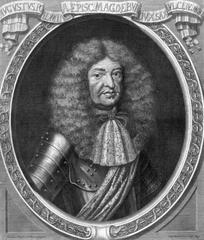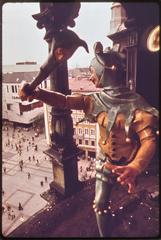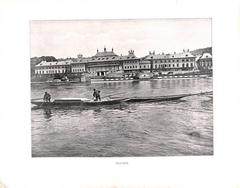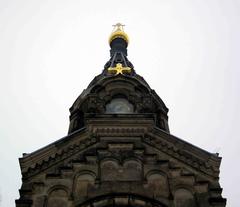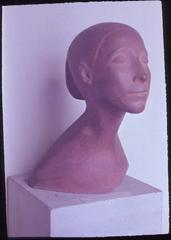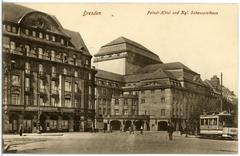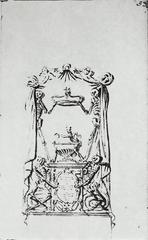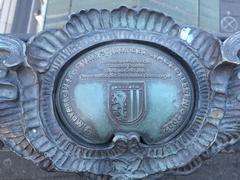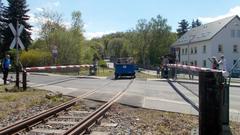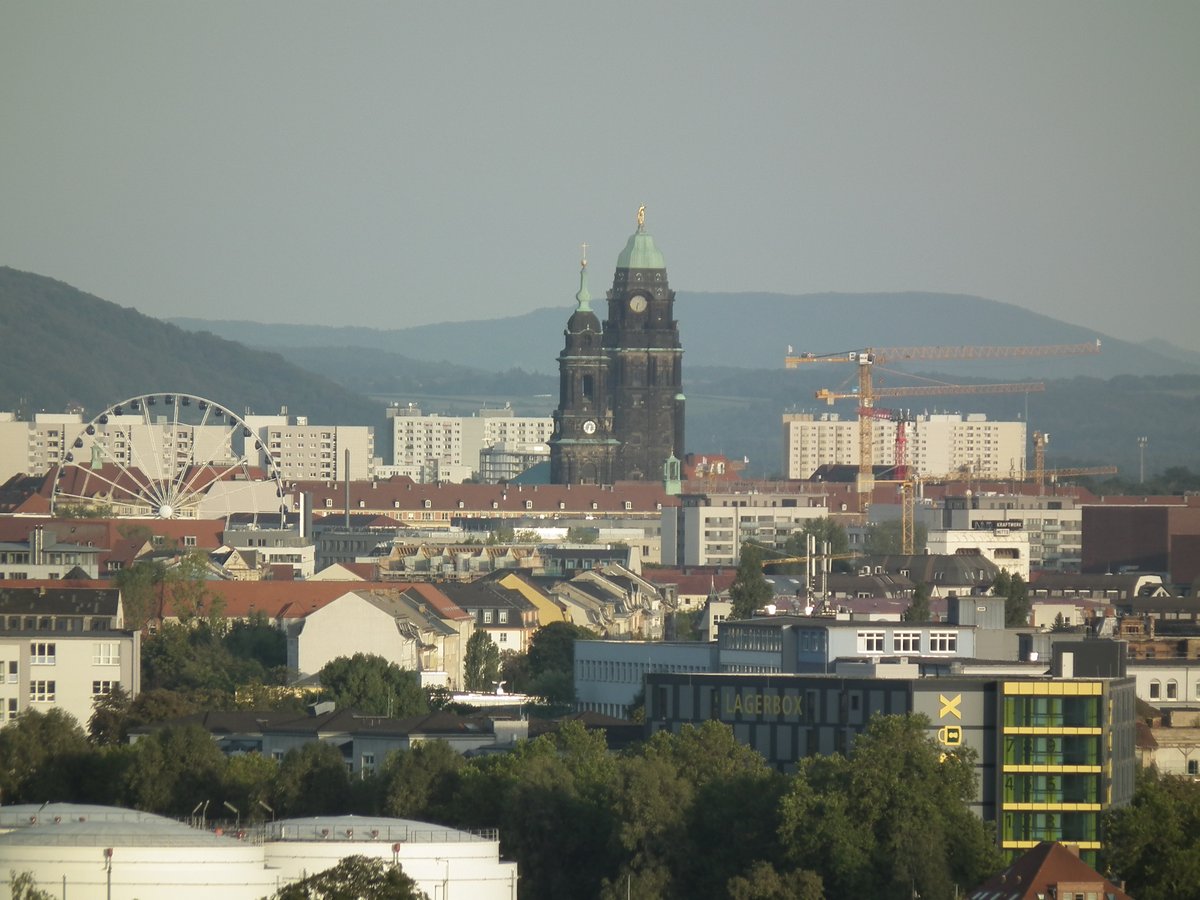
Kreuzkirche Dresden: Visiting Hours, Tickets, and Historical Significance Guide
Date: 14/06/2025
Introduction
The Kreuzkirche Dresden, or Church of the Holy Cross, is a defining monument in the heart of Dresden’s Altmarkt. With origins in the mid-12th century, it stands as one of Saxony’s largest Protestant churches and a symbol of Dresden’s resilience, faith, and cultural vibrancy. Through centuries of fires, wars, and reconstructions, the Kreuzkirche has evolved architecturally and spiritually, reflecting both the hardships and the enduring spirit of the city. Today, it serves as a vibrant center for worship, sacred music, and community life, drawing visitors from around the world (Wikipedia, MDR).
This guide provides a detailed overview of the Kreuzkirche’s layered history, architectural features, cultural and spiritual significance, and comprehensive visitor information, including opening hours, ticket details, accessibility, events, and nearby attractions. Whether you are a history enthusiast, architecture aficionado, music lover, or traveler, this article will help you plan a memorable visit to one of Germany’s most treasured landmarks (Kreuzkirche Dresden Official Site).
Table of Contents
- Introduction
- Historical Overview
- Early Foundations and Medieval Development
- Late Gothic Reconstruction and the Reformation
- Baroque and Classical Turmoil: Fires, Wars, and Rebuilding
- The Second World War and Postwar Reconstruction
- Preservation, Restoration, and Contemporary Significance
- The Kreuzkirche in the 21st Century
- Architectural Evolution and Surviving Artifacts
- Architectural Features
- Cultural and Spiritual Significance
- Visiting the Kreuzkirche Dresden: Practical Information
- FAQ
- Conclusion
- References
Historical Overview
Early Foundations and Medieval Development
The Kreuzkirche’s origins date to the mid-12th century, when a Romanesque basilica served Dresden’s earliest merchant community. In 1234, a relic of the True Cross donated by Constantia von Babenberg led to the building of the Kreuzkapelle, eventually lending its name to the entire church (Wikipedia). By 1319, it was officially known as “ecclesia sanctae crucis,” and after a new high altar was consecrated in 1388, the designation “Zum heiligen Kreuz” became standard.
Late Gothic Reconstruction and the Reformation
After a catastrophic fire in 1491, reconstruction transformed the church into a late Gothic hall structure, completed by the turn of the 16th century. The Reformation deeply shaped its identity: in 1539, the first Lutheran service was held here, marking its role as the principal Protestant church of Dresden (Wikipedia).
Baroque and Classical Turmoil: Fires, Wars, and Rebuilding
The church suffered repeated destruction. The 1760 bombardment during the Seven Years’ War left only the steeple intact. A decades-long debate led to its reconstruction in a blend of late Baroque and early Neoclassical styles. Another fire in 1897 resulted in a Jugendstil (Art Nouveau) restoration, completed in 1900 (MDR).
The Second World War and Postwar Reconstruction
The 1945 Allied bombings devastated the church. The altar painting survived, but the interior was gutted. Reconstruction began in 1946 with a focus on structural integrity over ornamentation, resulting in an austere modernist interior—a lasting reminder of wartime destruction (Wikipedia, MDR).
Preservation, Restoration, and Contemporary Significance
In the early 2000s, restoration efforts preserved the postwar interior, recognizing its memorial value. Today, the Kreuzkirche is Dresden’s principal Protestant church, the seat of the Landesbischof, and home to the renowned Dresdner Kreuzchor—a boys’ choir with a 700-year tradition (MDR).
The Kreuzkirche in the 21st Century
The church is a focal point for remembrance and cultural events, such as the 2025 world premiere of Sven Helbig’s “Requiem A,” reinforcing its role in dialogue, peace, and reconciliation (Kunst & Musik Dresden, Dresden Magazin).
Architectural Evolution and Surviving Artifacts
The Kreuzkirche’s structure preserves layers from Romanesque, Gothic, Baroque, Neoclassical, Jugendstil, and modernist phases. Notable surviving artifacts include altar fragments, the altar painting, and remnants of medieval artwork now housed in the Dresden City Museum (Wikipedia).
Architectural Features
Exterior Design and Structure
The Kreuzkirche commands the Altmarkt with its monumental scale, capable of seating over 3,000 people (Kreuzkirche Dresden). The robust west tower, with its classical columns and balustrades, is a defining feature. The facade blends Baroque details—cornices and pilasters—with a restrained neoclassical massing, and the darkened stonework testifies to its turbulent past. The steeple, less slender than typical Gothic spires, asserts the church’s urban prominence. The tower survived several disasters and remains a central part of Dresden’s skyline (Google Arts & Culture).
Interior Architecture
The vast basilica nave accommodates worship and concerts, with three tiers of galleries providing excellent acoustics and sightlines—especially prized by the Kreuzchor (Kreuzkirche Dresden). The postwar interior is intentionally austere, with rough plaster walls and minimal ornament, focusing attention on the altar and music. The Jehmlich organ, with over 4,000 pipes, is a centerpiece for both services and performances (Kreuzkirche Dresden – Veranstaltungsinformationen).
Artistic Elements and Decorative Features
Postwar stained glass creates soft, diffuse lighting inside the church. Memorial plaques and inscriptions throughout the nave commemorate victims of war and the church’s history. Modern liturgical elements—altars, baptismal fonts, lecterns—are crafted in simple forms that harmonize with the overall design.
Cultural and Spiritual Significance
The Kreuzkirche is the seat of the Landesbischof of the Evangelical-Lutheran Church of Saxony and the spiritual home of the Dresdner Kreuzchor. It is a centerpiece of Protestant worship and identity in Dresden, reflecting the city’s journey through the Reformation, wars, and reunification.
The church’s connection to the Coventry Cross of Nails links it to international efforts for peace and reconciliation. The Kreuzchor, one of the world’s oldest boys’ choirs, performs regularly, and the church remains a major venue for sacred and classical music. Its role in remembrance culture, especially during anniversaries of the Dresden bombings, makes it a key site for dialogue and reflection (Kunst & Musik Dresden, Dresden Magazin).
Visiting the Kreuzkirche Dresden: Practical Information
Location and Access
Address: An der Kreuzkirche 6, 01067 Dresden, Germany
Located on the Altmarkt, the church is within easy walking distance of the Frauenkirche, Zwinger, and Dresden Castle. Public transport options include tram lines 1, 2, 4 to “Altmarkt,” and bus 62 to “Prager Straße” (Kreuzkirche Dresden Official Site).
Opening Hours
- Monday to Saturday: 10:00–18:00
- Sunday: 12:00–18:00 (after services)
- Hours may vary for holidays and special events. Always check the official website for current information.
Tickets and Admission
- General Entry: Free
- Observation Deck:
- Adults: €5
- Students: €2.50
- Children (6–14 years), Dresden Welcome Card/City Card holders: €1.50
Tickets are available on-site.
- Vespers (Saturday 17:00): €5 for program booklet; children under 14 free.
- Concerts and Special Events: Prices vary; tickets available via event calendar or etix.
Facilities and Accessibility
- Wheelchair Access: Main nave and restrooms are accessible; tower is only via stairs (over 250 steps).
- Restrooms: Available inside.
- Gift Shop: Souvenirs and religious items at entrance.
- Information Desks: Staff available for assistance.
Guided Tours and Events
- Guided Tours: Available for groups by advance arrangement; contact via official website.
- Self-Guided Visits: Brochures in multiple languages.
- Concerts: Regular performances by the Kreuzchor and guest artists; see event calendar.
Observation Deck
Climb the 94-meter tower (54-meter viewing platform) via spiral staircase for panoramic views over Dresden’s Old Town. The tower houses historic bells and a 3-meter clock.
Memorials and Artworks
- Memorial Chapel: Made of Meissen porcelain, commemorating victims of the 1945 bombing, with significant historical inscriptions.
- Charred Cross and Coventry Cross of Nails: Symbols of reconciliation.
- Artworks: Notably Anton Dietrich’s “The Crucifixion of Christ” and a relic of the True Cross.
Visitor Tips
- Best Visit Times: Weekday mornings are quieter; check concert schedules for music events.
- Photography: Allowed without flash except during services and concerts.
- Dress Code: Modest attire is advised.
- Language: German and English signage; staff can assist in English.
- Nearby Attractions: Frauenkirche, Zwinger, Semperoper, and Striezelmarkt are all within walking distance (Visit Dresden Elbland).
Frequently Asked Questions (FAQ)
What are the Kreuzkirche Dresden visiting hours?
Monday–Saturday: 10:00–18:00, Sunday: 12:00–18:00 (after services), but always check the official website for updates.
Is admission free?
Yes, general entry is free. Tickets are required for concerts, special events, and the observation deck.
Is the observation deck wheelchair accessible?
No, the tower is only accessible by stairs.
Are guided tours available?
Yes, group tours can be arranged in advance; brochures available for self-guided visits.
Can I attend a Kreuzchor performance?
Yes, but concerts often sell out; buy tickets in advance via the event calendar.
Are children welcome?
Yes, children are welcome for services, concerts, and the tower (discounted entry).
Is there a dress code?
Modest attire is suggested, especially during services.
Conclusion
The Kreuzkirche Dresden is a living testament to the city’s resilience, faith, and cultural richness. Its architecture—shaped by centuries of change—offers a unique blend of history and modernity, while its role as a spiritual and musical hub continues to inspire visitors. With central location, free general admission, accessible facilities, and a full calendar of concerts and events, the Kreuzkirche is an essential Dresden destination.
Plan your visit by checking current hours and events on the official website. For concert tickets and updates, subscribe to the music newsletter. Explore more with the Audiala app and discover other Dresden historical sites for a truly enriching experience.
References
- Wikipedia – Kreuzkirche (Dresden)
- MDR – Kreuzkirche Kreuzchor Dresden Geschichte Kruzianer Musik
- Kunst & Musik Dresden – Requiem A 2025
- Dresden Magazin – Gedenkjahr 2025
- Kreuzkirche Dresden Official Website
- Google Arts & Culture – The Ruins of the Kreuzkirche
- Visit Dresden Elbland – Kreuzkirche Dresden
